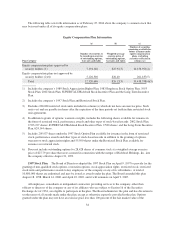Albertsons 2006 Annual Report Download - page 28
Download and view the complete annual report
Please find page 28 of the 2006 Albertsons annual report below. You can navigate through the pages in the report by either clicking on the pages listed below, or by using the keyword search tool below to find specific information within the annual report.In May 2005 the FASB issued SFAS No. 154, “Accounting Changes and Error Corrections—a Replacement
of APB Opinion No. 20 and FASB Statement No. 3” (SFAS No. 154). SFAS No. 154 requires retrospective
application as the required method for reporting a change in accounting principle, unless impracticable or unless
a pronouncement includes alternative transition provisions. SFAS No. 154 also requires that a change in
depreciation, amortization or depletion method for long-lived, non-financial assets be accounted for as a change
in accounting estimate effected by a change in accounting principle. This statement carries forward the guidance
in APB Opinion No. 20, “Accounting Changes,” for the reporting of a correction of an error and a change in
accounting estimate. SFAS No. 154 is effective for the year beginning February 26, 2006.
In March 2005 the FASB issued FASB Interpretation No. 47, “Accounting for Conditional Asset Retirement
Obligations—an Interpretation of FASB Statement No. 143” (“FIN 47”). FIN 47 clarifies that the term
“conditional asset retirement obligation” as used in FASB Statement No. 143, “Accounting for Asset Retirement
Obligations,” refers to a legal obligation to perform an asset retirement activity in which the timing and
(or) method of settlement are conditional on a future event that may or may not be within the control of the
entity. Accordingly, an entity is required to recognize a liability for the fair value of a conditional asset retirement
obligation if the fair value of the liability can be reasonably estimated. FIN 47 became effective for the company
during the fiscal year ended February 25, 2006 and did not have a material effect on the company’s consolidated
financial statements.
QUANTITATIVE AND QUALITATIVE DISCLOSURES ABOUT MARKET RISK
The company is exposed to market pricing risk consisting of interest rate risk related to debt obligations
outstanding, its investment in notes receivable and, from time to time, derivatives employed to hedge interest rate
changes on variable and fixed rate debt. The company does not use financial instruments or derivatives for any
trading or other speculative purposes.
The company manages interest rate risk through the strategic use of fixed and variable rate debt and, to a
limited extent, derivative financial instruments. Variable interest rate debt (commercial paper, bank loans,
industrial revenue bonds and other variable interest rate debt) is utilized to help maintain liquidity and finance
business operations. Long-term debt with fixed interest rates is used to assist in managing debt maturities and to
diversify sources of debt capital.
The company makes long-term loans to certain retail customers (see Notes Receivable in the accompanying
Notes to Consolidated Financial Statements for further information) and as such, holds notes receivable in the
normal course of business. The notes generally bear fixed interest rates negotiated with each retail customer. The
market value of the fixed rate notes is subject to change due to fluctuations in market interest rates.
28
























